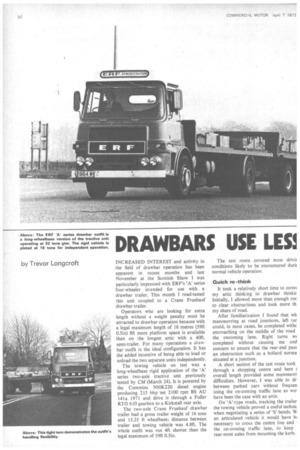DRAWBARS USE .LES! LOAD WIDTH
Page 32

Page 33

If you've noticed an error in this article please click here to report it so we can fix it.
INCREASED INTEREST and activity in the field of drawbar operation has been apparent in recent months and last November at the Scottish Show I was particularly impressed with ERF's 'A' series four-wheeler intended for use with a drawbar trailer. This month I road-tested this unit coupled to a Crane Fruehauf drawbar trailer.
Operators who are looking for extra length without a weight penalty must be attracted to drawbar operation because with a legal maximum length of 18 metres (59ft 0.5in) aft more platform space is available than on the longest attic with a 40ft. semi-trailer. For many operations a drawbar outfit is the ideal configuration. It has the added incentive of being able to load or unload the two separate units independently.
The towing vehicle on test was a long-wheelbase rigid application of the 'A' series two-axle tractive unit previously tested by CM (March 24). It is powered by the Cummins NHK220 diesel engine producing 215 bhp net 2100 rpm ES AU 141a 1971 and drive is through a Fuller RTO 610 gearbox to a Kirkstall rear axle. The two-axle Crane Fruehauf drawbar trailer had a gross trailer weight of 16 tons
and 15.25 ft wheelbase; distance between trailer and towing vehicle was 4.8ft. The whole outfit was run 4ft shorter than the legal maximum of 59ft 0.5in. The test route covered most drivii conditions likely to be encountered durii normal vehicle operation.
.Quick re-think
It took a relatively short time to cony( my artic thinking to drawbar thinkir Initially, I allowed more than enough roc to clear obstructions and took more th my share of road.
After familiarization I found that wh manoeuvring at road junctions, left tur could, in most cases, be completed withc encroaching on the middle of the •road the oncoming lane. Right turns wt completed without causing me und concern to ensure that the rear-end pass an obstruction such as a bollard norma situated at a junction.
A short section of the test route took through a shopping centre and here 1 overall length provided some manoeuvri difficulties. However, 1 was able to dr between parked cars without frequen using the on-coming traffic lane as wol have been the case with an artic.
On A'-type roads, tracking the trailer the towing vehicle proved a useful technic when negotiating a series of `S'-bends. IN an articulated vehicle it would have IN necessary to cross the centre line and , the on-coming traffic lane, to keep rear-most axles from mounting the kerb.
opposite lock the trailer bogie wheels ruld have crossed the centre road trkings. thus presenting a hazard to -coming traffic. The drawbar outfit named in its own lane-width through the ads.
The true advantage of the limited trailer 1-in was appreciated when negotiating ht roundabouts. A two-lane carriageway ith on the roundabout was comfortably circled, leaving adequate clearance ween rear axle and roundabout. On the ger roundabouts the reduced cut-in dency of the drawbar outfit left the mlative lanes on the roundabouts clear other traffic.
problems at lights Turning through a 320deg corner at ffic lights with the possibility of !ountering traffic waiting at the lights sented no problems. I took a slightly ler than normal approach and all xructions were cleared without any [ions glances in the rear-view mirror.
lie minus point was the intermittent ging effect felt in the cab. It was as if the ring eye and pin engagement was very allowing longitudinal movement of trailer relative to the towing vehicle.
Vehicle performance compared favoury to that of its tractive unit counterpart, ept that a steering vibration, felt only
once with the tractive unit, occurred more often with the drawbar, usually when pulling under full load.
A mechanically operated clutch is fitted and while the clutch pedal pressure required was not excessive, I preferred the hydraulically operated clutch of the artic unit.
The gear change presented no difficulties. Each ratio was selected without any hesitancy. The rev counter, instead of the speedometer, is situated directly ahead of the driver and affords more efficient use of the engine power. if properly used.
Steering could not be faulted. Rim pressure required to turn the wheel was comfortable; the 4.6 turns required from lock to lock allowed a precise and quick response to wheel movement, without any additional effort being required to keep the vehicle on a straight course.
The noise level in the cab is kept to an acceptable level enabling normal conversation to he heard across the cab under most engine load conditions.
As the interior of the cab is completely panelled, this also helps noise insulation. , The vehicle odometer read nearly 3000 miles at the end of our 90-mile run.
The fuel consumption figure of 5.9 mpg compares favourably with the tractive unit when operating over a similar type of terrain.




















































































